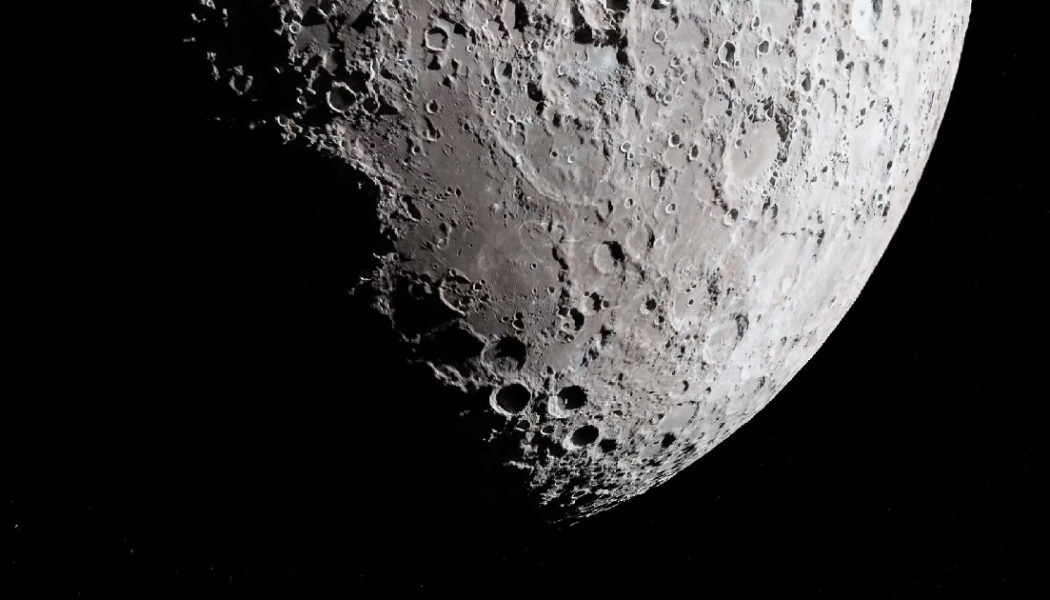
Studies so far have provided a tantalizing glimpse at best. But that’s about to change. Next year, robotic vehicles will enter the bewildering icy depths of PSRs for the first time, revealing what the interiors of these shadowed craters look like. By the decade’s end, NASA plans to send humans to explore in person.
On the eve of this new era of moon landings, a slew of fresh studies of PSRs have revealed that these shadowed regions are even stranger than scientists imagined. What will we find lurking in the shadows?
“I don’t know what we’re going to see,” said Robinson, the lead scientist for next year’s robotic mission. “That’s the coolest thing.”
Water, Water, Everywhere
Speculation about PSRs dates back to 1952, when the American chemist Harold Urey first hypothesized their existence on the moon. “Near its poles there may be depressions on which the sun never shines,” he wrote. He observed that, whereas Earth orbits the sun with its rotational axis tilted by 23.5 degrees, the moon orbits at a mere 1.5-degree tilt. This means the sun’s rays strike its poles nearly horizontally, and the rims of polar craters will block light from directly reaching their depths. However, Urey believed that any ice in these sunless locations would have been “rapidly lost” because of the moon’s lack of atmosphere.
Then in 1961, the geophysicist Kenneth Watson of Lawrence Berkeley National Laboratory theorized that ice could persist inside PSRs. Nightside temperatures on the moon were known to plunge to minus 150 degrees Celsius; Watson and two colleagues argued that this meant ice would get trapped in the coldest places, despite the exposure to space. “There should still be detectable amounts of ice in the permanently shaded areas of the moon,” they wrote.
Scientists debated the possibility of ice in PSRs until the early 1990s, when radar instruments detected signs of ice at the poles of Mercury, which was also thought to have permanently shadowed craters. In 1994, using a radar instrument on NASA’s Clementine spacecraft, scientists detected an enhanced signal over the moon’s south pole that was consistent with the presence of water ice. The hunt was on.
In 1999, Jean-Luc Margot at Cornell University and colleagues pinpointed PSRs on the moon that could contain ice. They used a radar dish in the Mojave Desert in California to make topographic maps of the lunar poles. “We simulated the direction of sunlight and used our topographic maps to identify regions that were permanently shadowed,” Margot said.
They located just a handful of PSRs, but subsequent studies have identified thousands. The largest measure tens of kilometers across inside giant craters, such as Shackleton crater at the lunar south pole, which is twice as deep as the Grand Canyon. The smallest span mere centimeters. At the Lunar and Planetary Science Conference held in Houston in March, Caitlin Ahrens, a planetary scientist at NASA’s Goddard Space Flight Center, presented research suggesting that some PSRs may grow and shrink slightly as temperatures on the moon fluctuate. “These are very dynamic cold regions,” Ahrens said in an interview. “They are not stagnant.”
New research indicates that some craters also contain double-shadowed regions, or “shadows within shadows,” said Patrick O’Brien, a graduate student at the University of Arizona, who presented evidence for the idea in Houston. While PSRs don’t experience direct sunlight, most receive some reflected light bouncing off the crater’s rim, and this can melt ice. Double-shadowed regions are secondary craters inside PSRs that don’t get reflected light. “Temperatures can be even colder than the permanent shadows,” said O’Brien; they reach as low as minus 250 degrees Celsius.
Icy Secrets
The double-shadowed regions are cold enough to freeze more exotic ices, like carbon dioxide and nitrogen, should any exist there. Scientists say the chemical composition of these and of the water ice inside PSRs could reveal how water got to the moon — and, more importantly, to Earth, and to rocky worlds in general. “Water is essential to life as we know it,” said Margaret Landis, a planetary scientist at the University of Colorado, Boulder. The question is, she said, “When and how did the conditions favorable for life on Earth form?” Whereas Earth’s past has been scrambled by geological processes, the moon is a museum of the solar system’s history; its ice is thought to have remained mostly untouched since its arrival.
There are three predominant theories about how water got to the moon. The first is that it arrived via asteroid or comet impacts. In this scenario, when the solar system formed, water molecules in the hot inner solar system were vaporized and blown away by the solar wind; only water in the frigid outskirts could condense and accumulate into icy bodies. These bodies subsequently bombarded the inner solar system, including the moon, delivering water. The second theory is that volcanic eruptions on the moon sometime in its middle age formed a thin, temporary lunar atmosphere that engendered ice formation at the poles. Or solar wind could have transported hydrogen to the moon that mixed with oxygen to form ice.
In February, a re-analysis of the LCROSS plume published in Nature Communications indicated that the ice in Cabeus crater is most likely of cometary origin. Analyzing the amount of nitrogen, sulfur and carbon frozen into the ice along with water, Kathleen Mandt of the Johns Hopkins University Applied Physics Laboratory and colleagues found that “the best explanation was comets,” said Mandt. “The nitrogen-to-carbon ratio was way beyond what was reasonable for volcanoes to have delivered.”
If the moon’s ice was delivered exclusively by comets, the same might have been true for Earth. That could mean rocky worlds must experience such impacts to accumulate the water necessary for life to flourish. However, Landis says it’s too early to say whether Mandt’s research holds true for all ice on the moon. “The community needs more time to digest it,” she said.
If some lunar ice is determined to be of volcanic origin, this would suggest worlds hold an innate ability to generate water from their interiors rather than relying on impacts. “It might be not all solar systems have lots of comets or asteroids,” said Landis, “but solar systems that form rocky planets might have this ability to have [volcanic] eruptions rear up water.”
Aside from looking for exotic ice in PSRs, scientists also want to measure the water ice’s proportion of deuterium, a heavier isotope of hydrogen. Substantial deuterium is more consistent with what’s found in comets (although rates vary), whereas less of it would point to solar wind. A volcanic origin would fall somewhere in the middle. Other elements will be informative, too; for instance, ice originating from volcanoes should contain abundant sulfur drawn up from the lunar interior, said Paul Hayne, a planetary scientist at the University of Colorado, Boulder.
Into the Abyss
No previous foray to the moon has ventured into its permanent shadows; the Apollo landings took place near the moon’s equator at a time when knowledge of PSRs was in its infancy. In 2019, China’s Chang’e-4 lander and rover touched down at the south pole, but it did not target PSRs.
In 2017, however, President Trump signed a directive to NASA to return humans to the moon, an initiative later named Artemis. Ahead of the first crewed Artemis landings in the mid-2020s, which may include the first sorties into the moon’s permanently shadowed craters, NASA is paying commercial companies to conduct initial robotic exploration.
Join Our Telegram Group : Salvation & Prosperity







